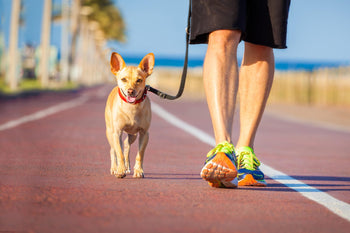What Happens To Dog Paws On Hot Days?

We wear shoes when we go outside to protect our tender skin from sharp rocks, debris and rough surfaces. We mostly take for granted that animals’ paws are made to endure the natural world around us, and do not give it a second thought when we step outside to take them for a walk.
BUT – IS YOUR DOG REALLY WALKING IN A NATURAL ENVIRONMENT? Probably not. Most likely he is walking on a man-made surface such as asphalt, pavement or concrete. And when it’s hot, those surfaces can become blistering hot, literally.
These surfaces can be so hot, even on a day you find pleasant, that your dog’s paws can burn and blister, causing a very painful injury that takes a while to heal and is difficult to treat.
Just How Hot Is Too Hot?
Here are some numbers that may shock you:
When it’s just 25 degrees outside, asphalt and tarmac can reach 52 degrees.
At 31 degrees, that surface heats up to 62 degrees!
How hot is that? You can fry an egg in five minutes at 55 degrees. And skin suffers burns in just one minute at 52 degrees.
Frostburg State University in Maryland, USA, did a test on common surfaces that we expect our dogs to walk on, including grass, track, asphalt, fake grass (astroturf), brick and concrete. The results are in the graph below, provided by Frostburg State University. Not surprising, the natural grass is the coolest. Most surprising, however, is that fake grass is actually the hottest – something to think about if you thought you were saving your dogs paws by putting him on astroturf.
How to Tell if the Surface Is Too Hot for Your Dog?
The easiest way for most people to tell is to try the five-second rule. Put your hand on the surface. If you can’t leave your hand on the surface, comfortably, for five seconds, it’s too hot for your dog. Also pay attention to the temperature outside and remember the numbers we gave above. Walking in the early morning or the evening, if the pavement has cooled enough, can help. When in doubt, take precautions such as finding some grass to walk in, or paw protectors like booties.
HEAT IS NOT THE ONLY CAUSE OF DAMAGED PAWS
Even when the weather is fine and the ground is cool, other things can damage your dog’s paws. Anyone who competes with their dog in agility or herding, for example, knows that dogs running at high speeds on rough ground can easily get tears or rips. Agility equipment is made with grippy surfaces, usually paint mixed with sand, that can definitely cause damage to tender paws. Newbies to the sport should try and limit their dogs speed and sudden stops on the equipment until their paws have had time to toughen up.
Those that are running on strange turf, like bark chips in a herding pen, also need to be careful for the same reasons. While our dogs’ pads are tougher than our own feet, they are not indestructible and just like us, they need time to get used to the new surfaces and build up calluses that protect against injuries.
If your dog is a mostly indoor dog that has a nice soft grassy backyard, his pads are probably pretty soft. Even just taking a dog that is used to being on grass to the beach (remember, sand is rough!) or for a walk or run on rough pavement can get scraps or even tears.
If your dog does get a pad injury, you will probably end up at the veterinary office. The injured paw(s) will need to be thoroughly cleaned to prevent infection and then you will either have to keep them wrapped or put booties on to allow the pads time to heal. It’s no fun to try and keep a dog pad clean and wrapped while on the mend, so the best thing do is try and prevent and injury from occurring by checking the temperature, and giving you dog’s pads time to toughen up when introducing them to a new surface.








